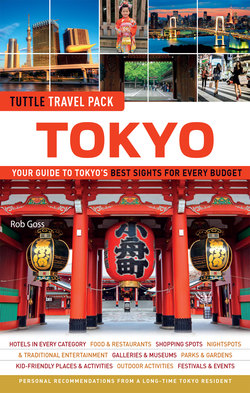Читать книгу Tokyo Tuttle Travel Pack - Rob Goss - Страница 10
На сайте Литреса книга снята с продажи.
ОглавлениеCHAPTER 2
EXPLORING TOKYO
Nezu Shrine
At turns futuristic, at others unerringly traditional, in places tranquil but most often invigoratingly un-Zen like, the patchwork of districts that comprise Tokyo’s core make the city hard to define. Next to the chic stores and fashions of Omotesando are the sanctity of Meiji Jingu Shrine and the brash teen fashions of Takeshita-dori. Rubbing shoulders with the traditional landscaping of Hama-Rikyu Gardens are the glistening towers of the Shidome area and the sprawling warehouses of the Tsukiji Fish Market. Like a mini Tokyo within Tokyo, Shinjuku has bits of everything. The area guides that follow will help you discover not just the best Tokyo has to offer but each of the contrasts, faces, traditions and quirks that make the city such a vibrant and unforgettable place to visit.
1 Tsukiji, Ginza and the Imperial Palace
2 Omotesando, Harajuku and Shibuya
3 Asakusa
4 Ueno and yanesen
5 Akihabara and Shinjuku
6 Roppongi
7 Odaiba
8 A Day Trip to kamakura
9 A Day Trip to yokohama
10 An Excursion to Nikko
11 An Excursion to Hakone and Mount Fuji
EXPLORING TSUKIJI, GINZA AND THE IMPERIAL PALACE
A tour of downtown Tokyo
See pull-out map H7; H10; J9–10
Some cities, it is said, never sleep but Tokyo isn’t one of them. Despite the crushing crowds of the morning rush-hour trains as millions of office workers descend on central Tokyo to meet their 9 a.m. check-in, Tokyo doesn’t have all that much for early risers. Besides temples and shrines, most tourist attractions and shops don’t open until about 10 a.m. The Tsukiji Fish Market is a welcome exception to that rule.
By 5.30 a.m., just as the first trains of the day are starting up their engines, Tsukiji is already at fever pitch, its frenetic auctions and army of 60,000 wholesalers, buyers and shippers combining to shift somewhere in the region of 2,000 tons of seafood and other fresh produce daily. A visit here for the early morning tuna auctions is well worth a pre-dawn alarm call (see Tokyo’s ‘Don’t Miss’ Sights, page 11, for a more detailed look at both the auctions and Tsukiji Market in general), but even if you get here by 9 a.m., several hours after the auctions have ended, you’ll still be able to soak up Tsukiji’s bustling atmosphere and land a great sushi breakfast at one of the many small sushi restaurants in and around the outer market area.
By the time you finish breakfast, Tsukiji’s neighbors will just about be waking up—and there are several good areas nearby to check out. Ten minutes southwest are Hama-Rikyu Gardens (Tokyo’s Best Parks and Gardens, page 77), a lovely mix of landscaped stroll garden and less-tended flower fields, above which the gleaming skyscrapers of the Shiodome district loom large. Heading a similar distance north from Tsukiji, taking Shin-ohashi-dori and then turning left onto Harumi-dori, comes the Kabuki-za Theater, Tokyo’s premier venue for Kabuki—a classical dance-drama defined by its elaborate costumes and make-up and the heavily stylized approach taken by the players. Reopened in 2013 after a long period of refurbishment, but still with a very traditional design, it’s at least worth passing by to take in the building itself, if not to book tickets for one of the plays (www.kabuki-za.co.jp; English audio guides are available, and you can also attend for a single act rather than sitting through a full performance of several hours).
Chuo-dori in Ginza is home to numerous high-end brands
The Wako Building (left) and Mitsukoshi at the Ginza Crossing
From Kabuki-za, it’s a walk of several hundred meters farther up the road to the Ginza Crossing, the center point of the Ginza area—Tsukiji’s most illustrious neighbor. Ask any Japanese about Ginza and you can guarantee one of the first things they will tell you is that the area is home to many of Tokyo’s finest restaurants, or many of the city’s most exclusive department stores and boutiques, or even its most expensive hostess clubs. Whichever response you get, it’ll somehow tie into wealth and the conspicuous consumption of it.
That association with wealth goes back centuries, to 1612 when Tokugawa Ieyasu chose Ginza as the site for a silver coin mint (gin za actually means silver mint), but it wasn’t really until the onset of the Meiji era, 260 years later, that Ginza began to take its current shape. From the late 1870s onwards, after centuries of Edo isolation, the Western-influenced Meiji government took to rebuilding Ginza and other central districts, replacing the cramped wood-built neighborhoods, which were susceptible to fast-spreading fire, with European-style architecture and street planning. Rickshaws gave way to horse-drawn trams and later electric trams, while new paved sidewalks and street gaslights blended with brick and stone buildings (designed and built by European architectures and later their Japanese apprentices) to give Ginza a very Western make-over.
